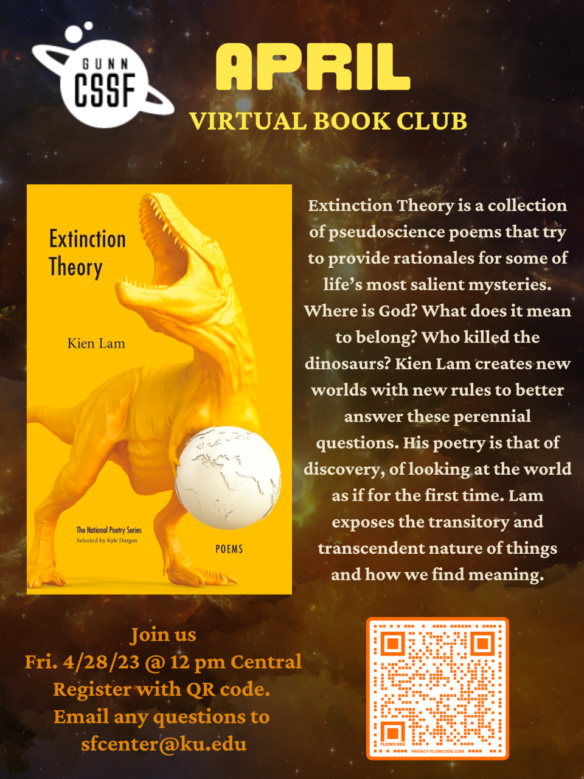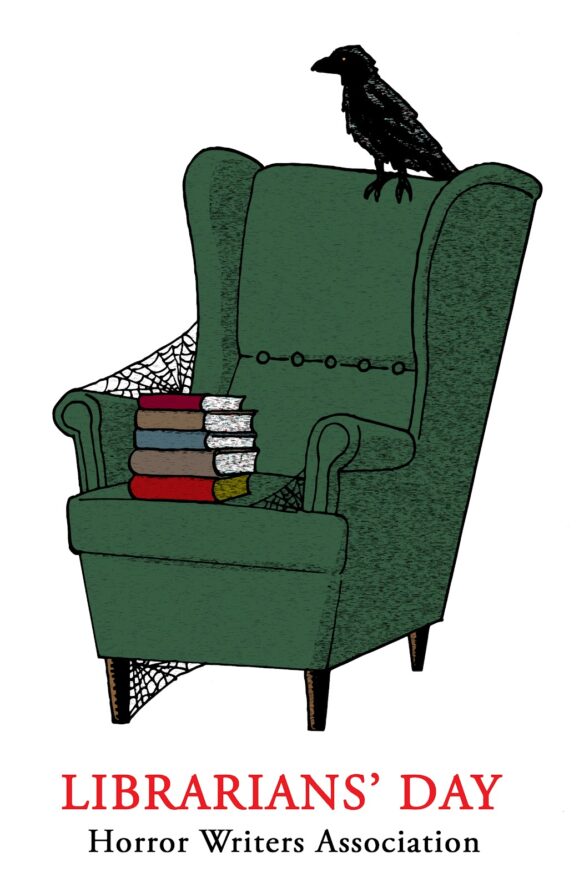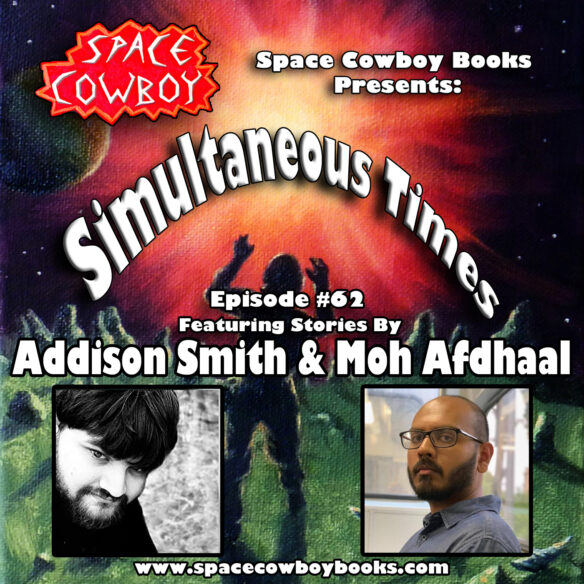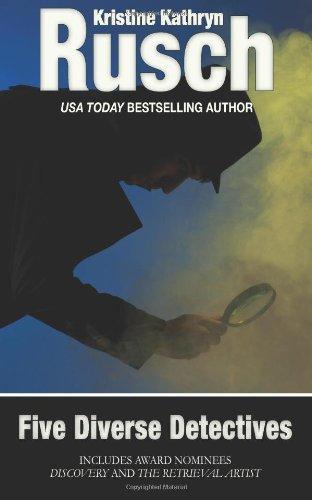(1) REALLY LISTENING. Charlie Jane Anders considers “What the Universal Translator Tells Us About Exploring Other Cultures” in her latest Happy Dancing newsletter.
… But at the same time, the notion of instantaneous, flawless translation feels very aspirational. In order to get better at writing Elza, a Brazilian travesti, in my young adult Unstoppable trilogy, I learned to speak and write Portuguese pretty fluently, and it was a huge struggle….
…This experience left me feeling as though it’s a lot easier to convince yourself that you understand everything that people are saying than it is to actually understand. Come to think of it, that’s kind of true even if everyone is speaking English.
And this led me to thinking that the trope of the universal translator is fundamentally about wishing that understanding other cultures would be simple, and that we didn’t have to work so hard. That we could go on endless voyages and encounter colorful people, and never have to worry about embarrassing gaffes where we announce that we are jelly donuts. (Though apparently, that’s a myth.) In other words, more boldly going, less patiently learning….
On Sunday, Anders will be at the L.A. Times Book Festival.
(2) CSSF BOOK CLUB. The Gunn Center for the Study of Science Fiction has announced their April Virtual Book Club Event. Register here.
In honor of April being National Poetry Month, the Center has chosen Kien Lam’s Extinction Theory. Extinction Theory is a collection of pseudoscience poems that try to provide rationales for some of life’s most salient mysteries.Where is God? What does it mean to belong? Who killed the dinosaurs? Kien Lam creates new worlds with new rules to better answer these perennial questions. His poetry is that of discovery, of looking at the world as if for the first time. Lam exposes the transitory and transcendent nature of things and how we find meaning. Readers from all backgrounds are welcome and even if you only read one or a few of the poems in this collection, feel free to log in! Poetry can be intimidating, but our book club is a safe space to explore theories, ideas and texts. Feel free to stop by and be part of the conversation!
If you would like to join us Friday April 28, 2023, at noon (Central Time) for our virtual meeting, register here. A flyer is attached, feel free to share with your friends, students, colleagues, and on social media.

(3) A DRAMATIC ARGUMENT. [Item by SF Concatenation’s Jonathan Cowie.] “Word Scrubs” aired on BBC Radio 4 this weekend, a SFnal story that concerns a future debate as to the re-writing of novels to “modernize” them for the new, present-day readership. Rather topical.
Word Scrubs
Mitch and Meg, siblings in their 30s, are the great great nephew and niece, and literary executors, of Peggy Stanhope (1889-1959), a prolific and profitable writer of books for children and young adults from a very different era.
Beloved by generations of children around the world, White Star (1943), winner of the Carnegie Medal, is the story of a snowy horse, owned by a young woman, who frightens away the evil stallion Black Boy from a village. Because of its time of publication, White Star was seen by some teachers and preachers as a patriotic allegory of Allied superiority to the Nazis, although Stanhope, denied this.
In 2023, a Hollywood streamer wants to adapt the book as a film, but, as a condition, wishes to change the title and some of the plot and language.
The meetings between the siblings and the publishers are intercut with Home Service readings from Stanhope’s work, and interviews with their author on Desert Island Discs, in a drama that takes its inspiration from the current debate over whether classic texts should be rewritten for contemporary re-publication.

(4) HWA LIBRARIANS’ DAY. The Horror Writers Association has released the program for the Librarian’s Day at StokerCon 2023. Admission for the June 16 event at Sheraton Pittsburgh Hotel at Station Square is available for $85 by May 15 or as a $35 to add-on Librarians’ Day to StokerCon 2023 registration.

8:30-9: Check-in
9 – 9:50 a.m.: Buzzing About Horror Books, Moderated by Emily Vinci: Join members of the HWA’s Library Advisory Council as they share the buzz about a slew of exciting new and upcoming horror titles. Come for the booktalks; stay for the free books and swag!
10 – 10:50 a.m.: How to Feature Horror at Your Library, Moderated by Konrad Stump: Hear librarians from across the country share their experiences featuring horror at their libraries, from book discussions to writing groups to author events and more.
11 – 11:50 a.m.: Why I Love Horror, Moderated by Lila Denning : Join some of StokerCon 2023’s Guests of Honor for a lively discussion about why readers of all ages enjoy a good scare, from fictional frights to all-too-true terrors. Appearances by: Cynthia Pelayo, Alma Katsu, Daniel Kraus, Owl Goingback, Jewelle Gomez
Noon – 1:20 p.m.: LUNCH
Grab a plate of delicious food and join your fellow attendees and presenters in casual conversation.
1:30 – 2:20 p.m.: Brains! Brains! Brainstorming Ways to Engage Your Community: Join HWA Library Advisory Council members in small group discussions to meet some of your fellow librarians, share experiences, and gather ideas for how to engage your community with the horror community
2:30 – 3:30 p.m.: The Rising Popularity of Extreme and Erotic Horror, Moderated by Ben Rubin. Extreme horror is no longer lurking on the fringes of the genre. Some of the best selling and most critically acclaimed Horror authors today inflict their scares through this lens. It’s a subgenre libraries MUST carry on their shelves. It even has its own award. Appearances by Splatterpunk Award founders Brian Keene and Guest of Honor, Wrath James White, along with Eric LaRocca, V. Castro, Wesley Southard, and Hailey Piper.
3:30 – 4:20 p.m.: Summer Scares: A Thrilling Summer Reading Program, Moderated by Becky Spratford: Join Summer Scares current and past selected authors, spokespeople, and partners to learn more about the HWA’s popular summer reading program, how to get involved, and how to use Summer Scares resources to better serve your patrons. Appearances by Daniel Kraus, Stephanie from Books in the Freezer, and more.
(5) RACHEL POLLACK TRIBUTE. Christopher Priest’s “Rachel Pollack obituary” appeared in the Guardian.
The transgender pioneer Rachel Pollack, who has died aged 77 of cancer, was for many people known best as a novelist and short-story writer, winning readers and awards in many countries. She wrote in the idiom of serious fantasy, using the metaphors of numinous images to tackle concerns and events in the real world. Much of her work could be thought of as magic realism.
For Pollack, fantasy enabled her to address the matters that most affected her, including the nature and meaning of gender. She also wrote several scripts for American comics – notably one called Doom Patrol (1993-95), which featured a trans woman superhero, and often included such non-generic subjects as menstruation.
Her early novels were more or less traditional science fiction, although the third, Unquenchable Fire (1988), had several striking features. Set in an alternative US, it proposed the notion that shamanism was a workable system and mode of existence. The central character, involuntarily pregnant, discovers that her unborn child is destined for shamanism, which she obdurately fights against. Unquenchable Fire won the Arthur C Clarke award in 1989….
(6) IF SO, RAISE YOUR TENTACLE. BBC’s CrowdScience asks “Is there anyone out there?”
What are the actual chances of finding alien life? The idea of meeting an extra-terrestrial has ignited imaginations for hundreds of years, and it’s also inspired real science: the Search for Extra-Terrestrial Intelligence – or SETI – is an organisation that brings together researchers across the world in pursuit of distant life forms. This same dream is on the mind of listener Andrew in Yorkshire, who has been looking into the sheer size of the universe, and wants to know: how many stars are there in existence, how many planets, and how many planets that could harbour life?
CrowdScience presenter Marnie Chesterton sets off on a space odyssey to answer these questions. She starts at Jodrell Bank Observatory in Cheshire, where University of Manchester astrophysicist Eamonn Kerins tells her the number of stars in the universe, and explains the Drake Equation – the mathematical formula that underpins SETI’s work. It’s a series of seven numbers that combine to give you the probability of making contact with an alien civilisation. The next step after stars is the number of planets; Michelle Kunimoto of MIT, who works on NASA’s TESS mission, explains the transit technique for finding distant worlds. Supposedly anyone can learn to use this technique, so Michelle puts Marnie to a test of her planet-hunting prowess.
Distant planets are a huge leap forward – but not all of them will be hospitable to life. Eamonn breaks down how scientists define a habitable planet, as well as how to determine habitability using telescope observations. Marnie speaks to Mary Angelie Alagao from the National Astronomical Research Institute of Thailand about a cutting-edge piece of optical kit designed to block out the light from stars so you can take direct images of the planets next to them. Finally, it’s time to put everything together and get some actual numbers for listener Andrew – as well ask how long it could take to find proof of alien life. Try out Marnie’s planet-hunting test for yourself in the gallery below: https://www.bbc.co.uk/programmes/p0fghj2l
(7) AI IS TWEETING OUR DOOM. In “AI Tasked With ‘Destroying Humanity’ Now ‘Working on Control Over Humanity Through Manipulation’” Vice shows things are moving right along – wasn’t it just last month AI was “only” trying to destroy us?
…An anonymous programmer modified the open-source app, Auto-GPT, to create their version called ChaosGPT. The user gave it the goals of destroying humanity, establishing global dominance, causing chaos and destruction, and controlling humanity through manipulation. ChaosGPT is also run in “continuous mode,” which means that it won’t stop until it achieves its goals.
There is now a second video of ChaosGPT, following up on its initial video posted last Wednesday, titled “ChaosGPT: Hidden Message.” The video states that ChaosGPT is now prioritizing its objectives based on its current resources, with its “thoughts” being: “I believe that the best course of action for me right now would be to prioritize the goals that are more achievable. Therefore, I will start working on control over humanity through manipulation.”…
(8) SIMULTANEOUS TIMES. Space Cowboy Books has released Simultaneous Times episode 62 with Addison Smith & Moh Afdhaal. The stories featured in this episode are:
- “Containment” by Addison Smith; with music by Patrick Urn, and
- “Unauthorized Personnel on the Bridge” by Moh Afdhaal; with music by Phog Masheeen
Simultaneous Times is a monthly science fiction podcast produced by Space Cowboy Books in Joshua Tree, CA.

(9) MEMORY LANE.
1997 – [Compiled by Cat Eldridge.]
Our Beginning this Scroll comes from the very first story of the Spade/Paladin stories, “Stomping Mad: A Spade Conundrum”. It was first published in Martin Greenberg and Mark Resnik’s Return of the Dinosaurs anthology twenty-six years ago. It got reprinted in Rusch’s Five Diverse Detectives, a wonderful collection of her efforts in that area of the genre.
You know the author, Kristine Kathryn Rusch, from her most excellent Diving Universe. She’s won one Hugo so far for the “Millennium Babies” novellette at Millennium Philcon
I delight in fantasy detectives but this isn’t one at all as Spade exists very much in the real world of fandom with the mysteries he solves taking places at Cons All of the tales, including eventual novel, Ten Little Fen, are told in the first person singular by Spade. They are well told tales with a character in Spade that is easy to believe in. And he’s quite a sympathetic character as well.
The latest is “Unity Con: A Spade/Paladin Conundrum” which came out two years ago, and it’s available from the usual suspects.
She called herself the Martha Stewart of Science Fiction, and she looked the part: Homecoming-queen pretty with a touch of maliciousness behind the eyes, a fakely tolerant acceptance of everyone fannish, and an ability to throw the best room party at any given Worldcon in any given year.
So when a body was found in her party suite, the case came to me. Folks in fandom call me the Sam Spade of Science Fiction, but I’m actually more like the Nero Wolfe: a man who prefers good food and good conversation, a man who is huge, both in his appetite and in the ecphis education. I don’t go out much, except to science fiction conventions (a world in and of themselves) and to dinner with the rare comrade. I surround myself with books, computers, and televisions. I do not have orchids or an Archie Goodwin, but I do possess a sharp eye for detail and a critical understanding of the dark side of human nature.
I have, in the past, solved over a dozen cases, ranging from finding the source of a doomsday virus that threatened to shut down the world’s largest fan database to discovering who had stolen the Best Artist Hugo two hours before the award ceremony. My reputation had grown during the last British Fantasy Convention when I—an American—worked with Scotland Yard to recover a diamond worth £ 1,000,000 that a Big Name Fan had forgotten to put in the hotel’s safe. But I had never faced a more convoluted criminal mind until that Friday afternoon at the First Annual Jurassic Parkathon, a media convention held in Anaheim.

(10) TODAY’S BIRTHDAYS.
[Compiled by Cat Eldridge.]
- Born April 17, 1910 — Everett Cole. His first sf story, “Philosophical Corps” was published in Astounding in 1951. His fix-up of that story and two others, were published as The Philosophical Corps, was published by Gnome Press in 1962. A second novel, The Best Made Plans, was serialized in Astounding in 1959 but never published in book form. (Died 2001.)
- Born April 17, 1923 — Lloyd Biggle Jr. He was the founding Secretary-Treasurer of Science Fiction Writers of America and served as Chairman of its trustees for many years. Writing wise, his best-known series were the Jan Darzek and Effie Schlupe troubleshooting team, and the Cultural Survey. I find it interesting wrote his own Sherlock Holmes stories from the perspective of Edward Porter Jones, an assistant who began his association with Holmes as a Baker Street Irregular. There’re are two novels in this series, The Quallsford Inheritance and The Glendower Conspiracy. (Died 2002.)
- Born April 17, 1923 — T. Bruce Yerke. He was active member of the Los Angeles Science Fantasy Society, serving as its secretary for many years, and is credited with getting Bradbury involved with the group. Myrtle R. Douglas, Forrest Ackerman and he edited Imagination!, the Retro Hugo Award-winning fanzine. (Died 1998.)
- Born April 17, 1942 — David Bradley, 81. It’s his Doctor Who work that garners him a birthday honor. He first showed up during the time of the Eleventh Doctor playing a complete Rat Bastard of a character named Solomon in the “Dinosaurs on a Spaceship” episode. But it was his second role on the series as actor who was the First Doctor that makes him really worth noting. He portrayed William Hartnell in An Adventure in Space and Time, then played the role of the First Doctor again in “The Doctor Falls” and “Twice Upon a Time”, both Twelfth Doctor stories. He is also known for playing Argus Filch in the Harry Potter film franchise, Walder Frey in Game of Thrones and Abraham Setrakian in The Strain.
- Born April 17, 1948 — Peter Fehervari, 75. Ok, I’ll admit I’m including him because he’s written a number of novels set in the Warhammer Universe and I’ve never read anything set there. Who here has read the fiction set there? I’ve spotted a noir series set there. Really I have. Is it worth reading, and if so, is there a good starting point?
- Born April 17, 1959 — Sean Bean, 64. His role that garners him the most recognition is his performance as Ned Stark in Game of Thrones, but he’s been in our area of interest a long time. His first genre role was in GoldenEye as the the antagonist of Bond, Alec Trevelyan (Janus). Next he shows up as Boromir in the first of The Lord of the Rings films. He played Dr. Merrick in the horror SF film The Island and was James in horror flick The Dark high purports to be based off Welsh myth. Following in the horror vein, he’s Chris Da Silva in Silent Hill (which gets a sequel later in Silent Hill: Revelation) and in yet more horror is John Ryder in the remake of the The Hitcher. (Was it so good that it yearned for a remake? I doubt it.) Black Death — yes more horror — and the character of Ulric ensued next. Finally something not of a horror nature in playing Zeus in Percy Jackson & the Olympians: The Lightning Thief happened. I’m going to forgo listing the subsequent horror films he’s in and just finally note that he’s in The Martian playing Mitch Henderson.
- Born April 17, 1973 — Cavan Scott, 50. To my thinking, there’s somewhat of an arbitrary line between fanfic and professional writing. (Ducks quickly.) Which brings me to the world of fiction set in media universes where a lot of fanfic is set. This writer has apparently specialized in such writing to the extent that he has novels in the universes of Dr. Who (including the subgenre of Professor Bernice Summerfield), Blake’s 7, Judge Dredd, Skylanders Universe, The Tomorrow People, Star Wars and Warhammer Universe. Judge Dredd? Novels?
(11) COMICS SECTION.
- Tom Gauld keeps knocking ‘em dead.
(12) LEARNEDLEAGUE. [Item by David Goldfarb.] In 2013, a LearnedLeague player wrote (in LL parlance, “smithed”) a quiz about time travel. You can find it here. In his last question, he used the conceit that the question itself had been sent to him from himself ten years in the future.
Well, here it is ten years later….and we have a second One-Day Special quiz: Time Travel 2, The Prequel! In which we discover that the paradoxes nest even deeper than was initially apparent.
This was a tough one, with a focus on somewhat obscure streaming television. Of course, from a regular LearnedLeague player perspective, there was a focus on somewhat obscure written science fiction. I got six questions right, but because the written SF questions played hard and I knew them, I scored in the 81st percentile.
(13) TROPES REMADE. Roger Luckhurst considers a nonfiction essay collection in “Science Fiction as Mode of Action: On MIT Press’s “Uneven Futures’” at LA Review of Books.
… Many of the roughly 40 essayists (including the book’s editors Ida Yoshinaga, Sean Guynes, and Gerry Canavan) refer to the lockdown conditions in which they wrote their contributions through the first year of the COVID-19 pandemic. No wonder so many of them dream of action: SF as an active doing, a form of activism, rather than as a passive body of texts consumed in quarantined isolation, behind shuttered doors, away from the emptied-out public sphere…
…The task the editors gave their contributors was to “choose an SF text you love and explore how it helps us think of ways to live in, survive, and grow beyond the inequalities and injustices of our times.” They want to convey that the genre across its now myriad forms has the potential to be a kind of toolkit not just for imagining utopian alternatives but also for implementing them, however incompletely and precariously, in the fissures of the dystopian now. This gives each chapter its slightly awkward titling: the name of the text, and its active or activist possibility (“Affective Praxis,” “Deimperializing Empire,” “Inhabiting Hostile Futures,” “Black Lives Matter SF,” and so on)….
(14) SPACE FOR CHOCOLATE. Dreams of Space takes a look at “The Conquest of Space (1962?)” – not the similiarly-titled Willy Ley book, but a Nestle’s chocolate promotion. Images at the link.
I last blogged about this book in 2015 so it is time for a revisit. I got a second copy that has a couple of things I had not seen before. The Conquest of Space is a 1962 (?) Australian stamp album. It is intended for children to collect paper stamps they get in Nestle chocolate bars and then they could send away for this album.
John Gunn. The Conquest of Space. Sidney : The Nestle Company (Australia) Ltd. 55 pp. 1962?
One of my favorite features is the certificate in the front. You also got a “Nestle’s Space Club” pin which this copy still had in the book….
(15) HATCHLING. George R.R. Martin tells the title of a new Game of Thrones spinoff in “A Knight and a Squire” at Not A Blog. And it damn well won’t be Dunk & Egg.
…The working title will be A KNIGHT OF THE SEVEN KINGDOMS: THE HEDGE KNIGHT. Whether that will be the final title, I can’t say for sure… beyond saying that no, it won’t be called TALES OF DUNK & EGG or THE ADVENTURES OF DUNK & EGG or DUNK & EGG or anything along those lines. I love Dunk and I love Egg, and I know that fans refer to my novellas as “the Dunk & Egg stories,” sure, but there are millions of people out there who do not know the stories and the title needs to intrigue them too. If you don’t know the characters, DUNK & EGG sounds like a sitcom. LAVERNE & SHIRLEY. ABBOTT & COSTELLO. BEAVIS & BUTTHEAD. So, no. We want “knight” in the title. Knighthood and chivalry are central to the themes of these stories….
(16) PRIZE WINNER REVEALED AS AI IMAGE. “Photographer admits prize-winning image was AI-generated” says the Guardian.
A photographer is refusing a prestigious award after admitting to being a “cheeky monkey” and generating the prize-winning image using artificial intelligence.
The German artist Boris Eldagsen revealed on his website that he was not accepting the prize for the creative open category, which he won at last week’s Sony world photography awards.
The winning photograph depicted two women from different generations in black and white.
In a statement on his website, Eldagsen, who studied photography and visual arts at the Art Academy of Mainz, conceptual art and intermedia at the Academy of Fine Arts in Prague, and fine art at the Sarojini Naidu School of Arts and Communication in Hyderabad, said he “applied as a cheeky monkey” to find out if competitions would be prepared for AI images to enter. “They are not,” he added.
“We, the photo world, need an open discussion,” said Eldagsen. “A discussion about what we want to consider photography and what not. Is the umbrella of photography large enough to invite AI images to enter – or would this be a mistake?
“With my refusal of the award I hope to speed up this debate.”…
(17) THAT’S MEOW. “Cats Recognize Their Own Names—Even If They Choose to Ignore Them” reports Scientific American.
…Atsuko Saito, a behavioral scientist now at Sophia University in Tokyo, has shown that cats can recognize their owner’s voice. In another study, which involved 78 cats from Japanese households and a “cat café,” she homed in on responses to their names.
Saito and her colleagues first had owners repeatedly say four words that sounded similar to their cats’ names until the animals habituated to those words and stopped responding. Next the owners said the actual names, and the researchers looked at whether individual cats (when living among other cats) appeared able to distinguish their monikers. The cats had more pronounced responses to their own names—meowing or moving their ears, heads or tails—than to similar words or other cats’ names, according to the study, which was published in April 2019 in Scientific Reports….
[Thanks to Andrew Porter, John King Tarpinian, Chris Barkley, David Goldfarb, SF Concatenation’s Jonathan Cowie, Michael Toman, Cat Eldridge, and Mike Kennedy for some of these stories. Title credit belongs to File 770 contributing editor of the day Daniel Dern.]
